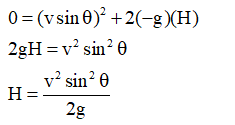A/1) In projectiles, why does a particle reach a velocity of zero? And at what height? Prove it mathematically. Assume that we have an ideal conditions of motion. Take the initial velocity of launching to be v at angle θ from the ground as shown in figure. A/2) One day, you were driving a car at a speed of 73.2 km/h and your eyes closed suddenly for a 0.4 sec. How far does the car move during that time in minutes?
A/1) In projectiles, why does a particle reach a
velocity of zero? And at what height? Prove it
mathematically. Assume that we have an ideal
conditions of motion. Take the initial velocity
of launching to be v at angle θ from the ground
as shown in figure.
A/2) One day, you were driving a car at a speed of 73.2 km/h and your eyes closed
suddenly for a 0.4 sec. How far does the car move during that time in minutes?
Note: Please answer sections A and B

(A) Given,
Initial velocity = v

When the particle reaches its maximum height, then vertical component of its velocity becomes zero.
This is because acceleration in vertical direction is acting downwards and opposite to motion of particle. So, gravity retards the motion of particle and hence its velocity decreases.
Initial vertical component of velocity, 
At height H,
Acceleration along vertical, 
Using  ,
,

Ans. At height  vertical velocity of particle is zero.
vertical velocity of particle is zero.
Step by step
Solved in 3 steps with 8 images









